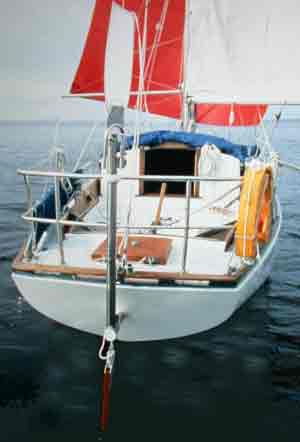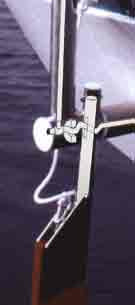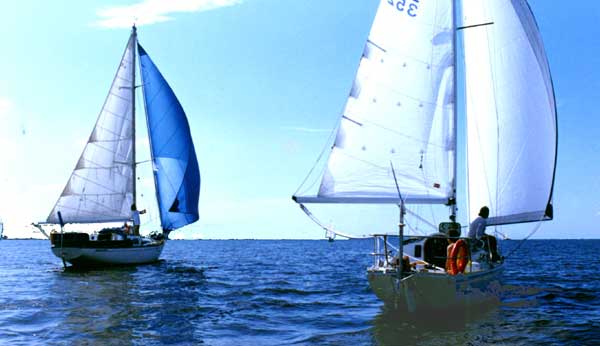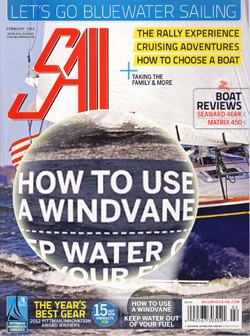|
CapeHorn renders other
Self-Steering Systems Obsolete.
The CapeHorn Integrated Self-Steering System
renders others obsolete in
more ways than one :
it is superior in its design
concept,
in looks, in strength and dependability,
in performance.
It is inferior in cost.
-
Design Concept
-
Up
to now, self-steering systems had been an afterthought, an add-on bolted
to a transom. The CapeHorn is integrated into the boat, and
becomes as much part of the whole as are an engine or a steering wheel.
Since the self-steering quadrant is placed inboard, it becomes possible to
lead the control lines to blocks fastened to the yacht’s steering
quadrant (and then to a
pair of jamming cleats in the cockpit), without having to lead
them to a drum on the wheel. This considerably reduces cockpit clutter.
It
also makes it possible to use a servo-pendulum system on a boat with a
hydraulic steering by leading the control lines
through blocks fastened on an auxiliary tiller or directly the short tiller to which the hydraulic ram is connected
(after turning the by-pass valve).
The
CapeHorn integrates all steering modes and affords the possibility
of controlling the servo-pendulum with a small autopilot placed inside
the lazarette. The
servo-pendulum still provides the energy needed to move the rudder,
considerably reducing the amperage consumed by the
autopilot. The added cost of a CapeHorn and of a small autopilot
will be much less than the cost
of a powerful autopilot needed to steer a
large boat and provides the best of both worlds. (The competition has
copied this feature after we came on the market, but their autopilots need
to be connected to the vane counterweight and remain exposed to the
weather.)
-
-
Custom-built
-
-
Contrary to other gears which are all
the same, only the mounting brackets being different,
each CapeHorn gear is
custom-built for a perfect fit and impeccable performance on each
boat it steers ; To solve a given problem on a boat with special stern
configuration or steering gear, we often
combine features of different models.
-
-
Looks
-
 Simple is beautiful. Who wants a plumbing shop attached to the stern of
his yacht? The structure of the CapeHorn could not be made more
simple or elegant: one horizontal tube to hold the horizontal axis and one
vertical to hold the windvane. No more. Simple is beautiful. Who wants a plumbing shop attached to the stern of
his yacht? The structure of the CapeHorn could not be made more
simple or elegant: one horizontal tube to hold the horizontal axis and one
vertical to hold the windvane. No more.
A
marine architect has spent a great deal of energy in creating a work of
art, a yacht that would be as pleasing to the eye as possible, only to see
his efforts ruined by the addition of a drilling rig on the stern of his
creation. This does not happen with the CapeHorn Self-Steering.
-
-
Strength and Dependablity
-
-
Self-steering systems were held in place with a structure made of tubes bolted to the stern. Then there were control lines that tended to twist
this structure, and the more load developed by the vane, the more twisting
force imposed on this structure.
-
On the
contrary, the structure of the CapeHorn also transmits the
movement: a tube links the servo-pendulum trailing behind the boat, to the
quadrant inboard, and pivots inside another tube fastened to the boat, an
installation as strong as the boat itself.
-
-
No Spare Parts
-
-
With
the CapeHorn, you do not need to buy
replacement parts . It is designed
so that these are not necessary. The CapeHorn is
guaranteed for
28000 miles or one circumnavigation against damage caused by the wind or
the sea. No other manufacturer dares to offer a comparable guarantee.
-
-
Performance
-
Before the CapeHorn came on the market, self-steering systems had
a reputation of performing poorly downwind, especially in light air. This
is understandable : downwind, the apparent wind is at its weakest and
 the energy developed by the vane is often insufficient to overcome the inertia
and the friction inherent in the transmission system. the energy developed by the vane is often insufficient to overcome the inertia
and the friction inherent in the transmission system.
Windvanes
were made of plywood or a comparable material. The CapeHorn
windvane is much lighter : spinnaker cloth over a 1/8’’ (3 mm) wire and
reacts to the lightest impulse. (True, it could prove too light for heavy
weather; so a second vane, made of aluminium sheet replaces it when it is
time to reef.)
Transmission between the
 vane and the servo-pendulum was done through a
number of gears or connecting rods (or both). The CapeHorn needs
only one moving part between the connecting rod and the stock of the
servo-pendulum. This reduces friction considerably, making the system even
more sensitive. As a bonus, fewer moving parts also means less play
between parts, making the whole system much more precise. The travel of
the connecting rod is also shorter, which ensures a much quicker
transmission to the servo-pendulum of the signals given by the vane. vane and the servo-pendulum was done through a
number of gears or connecting rods (or both). The CapeHorn needs
only one moving part between the connecting rod and the stock of the
servo-pendulum. This reduces friction considerably, making the system even
more sensitive. As a bonus, fewer moving parts also means less play
between parts, making the whole system much more precise. The travel of
the connecting rod is also shorter, which ensures a much quicker
transmission to the servo-pendulum of the signals given by the vane.

All
this means the CapeHorn is the only windvane that really works
downwind in light air. The photo above shows two boats
self-steered in
light air, wing-on-wing, and there is no whisker pole
holding the clew of
either genoa to windward. We
have all tried to keep the sail from collapsing
while steering by hand and seen how difficult it
was ! This illustrates how precise a
course the CapeHorn steers. Whoever
suspects the photo was rigged can witness the same performance in the last shots
of the film With Jean-du-Sud Around the World : Jean-du-Sud
sails up the bay of Gaspé under this same sail combination; in the film,
the scene lasts a few minutes; in reality, it lasted a few hours! And
remember that the prototype had the wear and tear of a
28000 mile circumnavigation!
Witness Unmatched CapeHorn Performance
- Cost
-
CapeHorn is superior in all these respects. But
it costs less than most other systems on the market. Being simpler, it
costs less to fabricate.
-
This is what
we mean when we state :
the CapeHorn Integrated Self-Steering System renders others obsolete.
Suite : CapeHorn Self-Steering Gear
|
 Simple is beautiful. Who wants a plumbing shop attached to the stern of
his yacht? The structure of the CapeHorn could not be made more
simple or elegant:
Simple is beautiful. Who wants a plumbing shop attached to the stern of
his yacht? The structure of the CapeHorn could not be made more
simple or elegant:  the energy developed by the vane is often insufficient to overcome the inertia
and the friction inherent in the transmission system.
the energy developed by the vane is often insufficient to overcome the inertia
and the friction inherent in the transmission system.
 vane and the servo-pendulum was done through a
number of gears or connecting rods (or both). The CapeHorn needs
only one moving part between the connecting rod and the stock of the
servo-pendulum. This reduces friction considerably, making the system even
more sensitive. As a bonus, fewer moving parts also means less play
between parts, making the whole system much more precise. The travel of
the connecting rod is also shorter, which ensures a much quicker
transmission to the servo-pendulum of the signals given by the vane.
vane and the servo-pendulum was done through a
number of gears or connecting rods (or both). The CapeHorn needs
only one moving part between the connecting rod and the stock of the
servo-pendulum. This reduces friction considerably, making the system even
more sensitive. As a bonus, fewer moving parts also means less play
between parts, making the whole system much more precise. The travel of
the connecting rod is also shorter, which ensures a much quicker
transmission to the servo-pendulum of the signals given by the vane.


